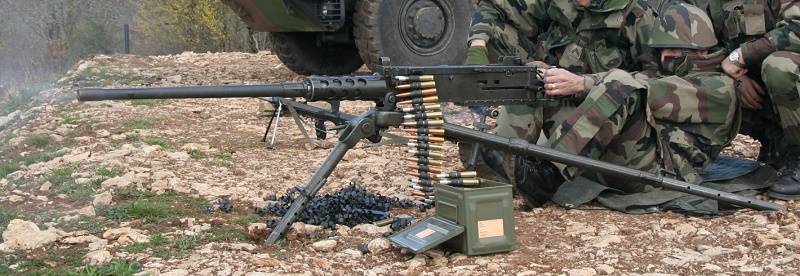Assault Weapons Laws: California Penal Code 30600, 30605, and 30610

California Penal Code section 30600 regulates the manufacture and transfer of two kinds of firearms: 1) those that are classified as assault weapons, and 2) a specific type of rifle, the .50 Browning Machine Gun (.50 BMG). The law states:
“Any person who, within this state, manufactures or causes to be manufactured, distributes, transports, or imports into the state, keeps for sale, or offers or exposes for sale, or who gives or lends any assault weapon or any .50 BMG rifle, except as provided by this chapter, is guilty of a felony, and upon conviction shall be punished by imprisonment pursuant to subdivision (h) of Section 1170 for four, six, or eight years.”1
The possession or ownership of these weapons is controlled under two separate statutes. California Penal Code section 30605 prohibits possession of an assault weapon, and California Penal Code section 30610 prohibits possession of a .50 BMG rifle.
What Constitutes an Assault Weapon?
Under current law, the “definition” of assault weapon in California is principally based on how the weapon is configured. Generally speaking, assault weapons can have any number of characteristics, including, but not limited to:
- Semi-automatic fire
- Capable of accepting various attachments, such as flash suppressors, folding/telescoping stocks, or grenade launchers
- Capable of accepting detachable magazines; or have a fixed magazine of more than 10 rounds
- An overall length of less than 30 inches2
The definition covers numerous types of pistols, shotguns, and rifles. The Penal Code also provides a non-exhaustive list of 70 specific weapons that are designated as assault rifles, any of which would qualify for punishment under Penal Code sections 30600 and 30605.3
Exceptions to Assault Weapons Laws
Like many other firearm control measures, there are a number of exceptions to the ban on assault weapons and .50 BMG rifles that will allow you to legally posses, manufacture, or sell these firearms. Some of these exceptions include:
- You have a permit to manufacture and sell these weapons to law enforcement or military agencies;
- You administer an estate that legally owns an assault weapon or a .50 BMG rifle;
- You are involved in law enforcement sanctioned firearm exhibitions or target shooting;
- You are a resident of another state and are traveling for the purpose of participating in an organized competitive match or league competition that involves the use of such weapons; or
- You have a valid permit to specifically possess an assault weapon (other firearms permits are not valid for this law).4
Prosecution for Violating Assault Weapons Laws Under California Penal Code 30600, 30605, and 30610
Though the acts that are prohibited by each of these codes are slightly different, the elements of each crime are fundamentally the same. In order for you to be convicted of any one of these crimes, the prosecutor must prove beyond a reasonable doubt that you meet the following elements:
- You possessed, manufactured, caused to be manufactured, distributed, transported, imported, kept, offered or exposed for sale, gave, or loaned an assault weapon or a .50 BMG rifle;
- You knew that you did one or more of these acts; AND
- At the time you acted, you knew or reasonably should have known that the weapon had the characteristics of an assault weapon or .50 BMG rifle.
Penalties for Violating Assault Weapons Laws Under California Penal Code 30600, 30605, and 30610

A violation of California Penal Code section 30600 is a felony. Manufacturing, distributing, transporting, selling, giving away, or lending assault weapons or .50 BMG rifles is punishable by four, six, or eight years in county jail.
If you are convicted for merely possessing one of these weapons under California Penal Code sections 30605 or 30610, you face a “wobbler” charge, which means that it may be charged as either a felony or misdemeanor. A felony conviction would result in:
- 16 months, or two or three years in county jail; and
- A maximum fine of $10,000.
A misdemeanor conviction would result in:
- Up to 364 days in county jail; and
- A maximum fine of $1,000.
However, there are also infraction charges available under California Penal Code sections 30605 and 30610. These are available if it is your first conviction under these sections, you had no more than two weapons, and you meet all of the following criteria:
- You lawfully possessed the weapon or .50 BMG rifle prior to its classification as an assault weapon on January 1, 2005;
- You violated this law within one year of the end of the one-year registration period for the weapon; and
- You surrendered the weapon to law enforcement officers for the purpose of having it destroyed.
If you qualify for the infraction charge, you face a fine of $500.
One important note about punishments is each weapon is a separate count. For example, if you are arrested for possessing three assault weapons, you could face 48 months, or six or nine years in county jail, and a fine of $30,000.
Furthermore, the possession or use of an assault weapon while committing another crime is a factor that can be used to enhance your sentence for those crimes. So, for example, if you are convicted of armed robbery, and you had an assault weapon in your possession at the time, you will have another year added to the end of your sentence for robbery. If you actually fired the weapon, you could face an additional three to ten years.
Defenses to California Penal Code 30600, 30605, and 30610
The weapon is not an assault weapon or .50 BMG rifle.
Like many weapon laws, the characteristics of the weapon are critical to the determination of the case. Suppose that you have a pistol with a fixed magazine that in its standard configuration is capable of holding 12 rounds, and that is the sole characteristic that makes your pistol an assault weapon. However, because you wanted to be a law-abiding gun owner, you had the magazine permanently altered to accept only 10 rounds. California Penal Code section 12276.1 does not apply to magazines that have been altered in this manner.5 Therefore, if this is the weapon in question, you have a defense to a charge under California Penal Code section 30600 or section 30605.
You did not know the weapon qualified as an assault weapon.
When you see the phrase “known or reasonably should have known” in a criminal statute, your personal knowledge is an element of the crime, and you cannot be found guilty if you either had no knowledge or if it would have been unreasonable for you to know it.
Suppose in this case you inherited a pistol with the 12-round unaltered magazine from your uncle. You have no experience with guns, you never talked to your uncle about the pistol, you did no research about the model, and you never even pulled the clip from the pistol to determine its capacity. To you, it looks like any other legal pistol, but you decide that you do not want it, and so you decide sell it.
While driving to sell the weapon, you are stopped by the California Highway Patrol for speeding. The officer sees the weapon on the backseat of your car. He examines it and determines that it has a 12-round capacity, and arrests you for possessing an assault weapon under California Penal Code section 30605. Under these facts, you had no actual knowledge of the weapon’s sole illegal characteristic, nor was it reasonable for you to know that it was illegal. Thus, you should have a defense based on your lack of knowledge.
You had a valid permit to specifically possess an assault weapon.
Depending on your personal circumstances, you may be able to apply and be granted permission by California’s Department of Justice to have a valid permit to possess, manufacture, or sell assault weapons or .50 BMG rifles. For example, if you are a person who trains the police on how to use these weapons, you can apply to have one of these permits. However, in order to defend against charges of illegal possession or sale of assault weapons, you must have had a valid permit at the time you were arrested.
Frequently Asked Questions on Assault Weapons Laws
- What if my weapon is capable of accepting a modification to make it an assault weapon, but I never add the modification?
Assault weapons laws often repeats the phrase “capable of” when it lists some of the configurations that distinguish assault weapons from other types of weapons. For example, a weapon that is “capable of” having a forward grip attached is an assault weapon.
This means that all that is necessary for your weapon to be considered illegal is that it is has the ability to be adapted with one of the components that would make it an assault rifle, regardless of whether you add the additional component. If it can accept one of these optional components, it is likely to be deemed an assault weapon, and you could be convicted under California Penal Code sections 30600, 30605, or 30610.
- What if the weapon could not accept those modifications until after I personally modified it?
For these laws, who made the modification is not generally relevant. More important is when the modification is made. If you had the gun after it became capable of accepting these optional components, you can be charged with possessing an assault weapon, regardless of whether the adaptation was “homemade” or by the manufacturer.
- I am a collector of historical weapons. Is it illegal to possess an antique assault weapon?
No. Assault weapons laws specifically do not apply to any weapon that is “antique,” which is defined as any weapon produced before January 1, 1899. So, if you own a weapon that would otherwise fit the description of an assault weapon, but it was made before that date, you should not be convicted of possession of an assault weapon.
Contact Wallin & Klarich If You Have Been Charged with an Assault Weapon Crime

An assault weapon charge is a serious legal problem. However, if you are facing such a charge, you do not have to do so alone. You can hire an experienced criminal defense attorney who can give you the best chance of keeping your freedom. At Wallin & Klarich, our attorneys have over 40 years of experience successfully defending people like you who have been wrongfully accused of assault weapon crimes. Let us help you, too. We are committed to providing you with the personal attention you deserve, and to helping you overcome this difficult situation.
With offices in Los Angeles, Sherman Oaks, Torrance, Tustin, San Diego, Riverside, San Bernardino, Ventura, West Covina and Victorville, there is a Wallin & Klarich attorney experienced in California criminal defense near you, no matter where you work or live.
Call us today at (877) 4-NO-JAIL or (877) 466-5245 for a free phone consultation. We will be there when you call.
1. Cal. Pen. Code § 30600(a).↩
2. See Cal. Pen. Code §§ 12276.1 and 30515.↩
3. See Cal. Pen. Code § 30510 and 30515 for this list.↩
4. See, Cal. Pen. Code §§ 30625 et seq.↩
5. Cal. Pen. Code § 12276.1, subd. (d).↩
6. https://commons.wikimedia.org/wiki/File:Cal50_Browning_2REI.jpg

